RBSE Solutions for Class 6 Maths Chapter 14 Perimeter and Area In Text Exercise is part of RBSE Solutions for Class 6 Maths. Here we have given Rajasthan Board RBSE Class 6 Maths Chapter 14 Perimeter and Area In Text Exercise.
| Board | RBSE |
| Textbook | SIERT, Rajasthan |
| Class | Class 6 |
| Subject | Maths |
| Chapter | Chapter 14 |
| Chapter Name | Perimeter and Area |
| Exercise | In Text Exercise |
| Number of Questions | 19 |
| Category | RBSE Solutions |
Rajasthan Board RBSE Class 6 Maths Chapter 14 Perimeter and Area In Text Exercise
(Page No. 191)
Question 1.
Find the perimeter of following (RBSESolutions.com) rectangles

Solution:
(i) Perimeter of rectangle = 2 (l + b) = 2 (2 + 3) = 2 (5) = 10 cm
(ii) Perimeter of rectangle = 2 (l + b) = 2 (4 + 5) = 2 (9) = 18 cm
(iii) Perimeter of rectangle = 2(l + b) = 2 (4 + 4) = 2 (8) = 16 cm

(iv) Perimeter of rectangle = 2 (l + b) = 2 (7 + 2) = 2 (9) = 18 cm
![]()
(Page No. 194)
Question 1.
Find the perimeter of a regular polygon with (RBSESolutions.com) each side equal to 3.5 cm and number of sides equal to 3.
Solution:
length of each side = 3.5 cm
Total number of sides = 3
∴ Each side of regular polygon is equal
∴ Its perimeter = 3.5+ 3.5 + 3.5 = 10.5 cm
Question 2.
The perimeter of a regular polygon is 28 cm and its (RBSESolutions.com) each side equal to 7 cm. Find the number of sides of the polygon.
Solution:
perimeter of regular polygon = 28 cm
measurement of each side = 7 cm
Let number of sides in regular polygon is n,
then, Total length of all sides = perimeter of polygon
⇒ n × 7 = 28
⇒ 7n = 28
\(=n=\frac { 28 }{ 7 } = 4\)
∴ Regular polygon has 4 sides only.
Question 3.
Find the perimeter of (RBSESolutions.com) a square with each side equal to 4.5 cm.
Solution:
∴ Each side of square = 4.5 cm
Total number of sides in square = 4
Total length of all sides = Perimeter of square
= 4 × 4.5 = 18.0 cm
∴ Perimeter of square = 18 cm
(Page No. 198)
Question 1.
Put a leaf of a china rose plant and a leaf of a pepal tree on grid papers. Find (RBSESolutions.com) the estimated areas of both. Compare and tell which leaf has greater area?
Solution:
Check the solution of question given of page 197 of text Book
Text Book Questions
(Page No. 189)
Question 1.
We measure perimeter and (RBSESolutions.com) area only for closed figures. Think why?
Solution:
It is because, to find perimeter and area we required measurement of sides of figure, which can be found only in closed figures.
![]()
(Page No. 190)
Question 1.
Measure in centimeters and write the lengths of the four sides of a page of your note book. Also find the sum of the lengths of four sides.
Solution:
Do yourself.
Question 2.
Rashmi went to a park 120 m long (RBSESolutions.com) and 80 m wide. She took one complete round on its boundary. What is the distance covered by her?
Solution:
Distance covered in a complete round of park = perimeter of park = 2 (l + b)
= 2 (120 + 80) = 2 (200) = 400 m
Question 3.
Following figure is a closed figure (RBSESolutions.com) made of various line segments. Find the perimeter of the figure by adding the lengths of the line segments.
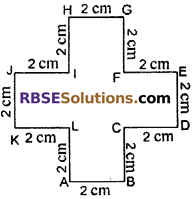
Solution:
Perimeter = AB + BC + CD + DE+ EF + FG + GH + HI + IJ + JK + KL + LA
= 2 + 2 + 2 + 2 + 2 + 2 + 2 + 2 + 2 + 2 + 2 + 2 = 24 cm
Thus, perimeter of figure is 24 cm.
Question 4.
Find the perimeter (RBSESolutions.com) of the following figure.

Solution:
Perimeter = PQ + QR + RS + ST + TU + UP
= 80 + 120 + 140 + 60 + 100 + 50 = 550 m
(Page No. 191)
Question 1.
Find the perimeter of the following (RBSESolutions.com) rectangles. Which rectangle has the greatest perimeter?
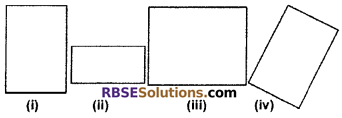
Solution:
(i) On measuring, l = 1.8 cm and b = 1.3 cm and
Perimeter = 2 (l + b)
= 2 (1.8 + 1.3) = 2 (3.1)
= 6.2 cm
(ii) On measuring l = 1.5 cm and b = 0.8 cm and
Perimeter = 2 (l + b)
= 2 (1.5 + 0.8) = 2 (2.3)
= 4.6 cm
(iii) On measuring l = 2.1 cm (RBSESolutions.com) and b= 1.6 cm and
Perimeter = 2 (l + b)
= 2 (2.1 + 1.6) = 2 (3.7)
= 7.4 cm
(iv) On measuring l = 1.8 cm and b= 1.2 cm and
Perimeter = 2 (l + b)
= 2 (1.8 + 1.2) = 2 (3)
= 6 cm
Thus, Perimeter of (iii) figure is greatest.
![]()
(Page No. 193)
Question 1.
Madhav and Ishaan are making (RBSESolutions.com) different polygons with the help of similar straws. Following are a few of the shapes they made

Measure of lengths of the sides of these figures and fill in the table.

Solution:

(Page No. 196)
Question 1.
The closed figures given below (RBSESolutions.com) occupy some space of a flat surface can you tell which one occupies more space ?

Solution:
Figure which looks bigger, occupy (RBSESolutions.com) more space. If there is less difference in size, then we can also measures to find it. But measurement is not needed in above figures.

(Page No. 197)
Question 1.
Can you tell which of the (RBSESolutions.com) following figures has larger area, just by looking them ?

Solution:
We can not say which figure has (RBSESolutions.com) more area just be looking them. Thus to find area we use square paper


We ignore ‘less than half – filled squares’ and (RBSESolutions.com) count ‘more than half-filled squares’ just as one square, then, sum of fully – filled and these is the estimated area of figure.
Area of china rose leaf = 25 sq. unit
and Area of pepal leaf = 15 sq. unit
Ratio of Area of china rose leaf to pepal leaf = 25 : 15 = 5 : 3
Thus, Area of china rose leaf is more.
![]()
(Page No. 198)
Question 1.
Place three rectangle A, B and C squared grid (RBSESolutions.com) paper or graph paper where every square measures 1 cm × 1 cm. Look at the figure and fill in the following table

make some more rectangle (RBSESolutions.com) and fill in the table

Solution:
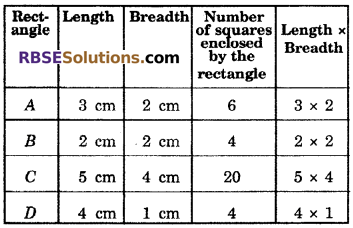
(Page No. 202)
Question 1.
Take a grid paper with every square (RBSESolutions.com) measures 1 cm × 1 cm. Take 22 pieces of thin string’s each 1 cm long. Place these strings on the gird paper and make different rectangles each with perimeter equal to 22 cm.
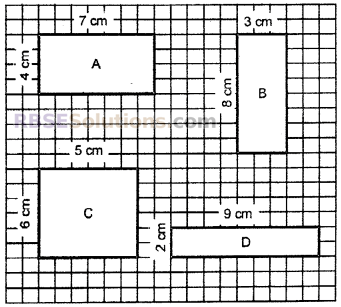
Fill the detail in the given table. For each figure, count (RBSESolutions.com) the number of squares unclosed and fill in the table
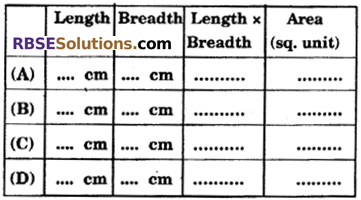
What do you infer (RBSESolutions.com) from table?
Solution:

Conclusion : Length increased as area decreased.
![]()
(Page No. 203)
Question 1.
Make as many rectangles as you can, such that (RBSESolutions.com) enclosed area of each rectangle is 24 squares. Fill the detail about their length and breadth in a table. What do you infer from the table?
Solution:
24 squares means, Area of rectangle 24 sq. cm, which comes with the following measurement of length and breadth :
1 cm and 24 cm ;
2 cm and 12 cm ;
3 cm and 8 cm and;
4 cm and 6 cm. (let 1 square = 1 sq. cm).
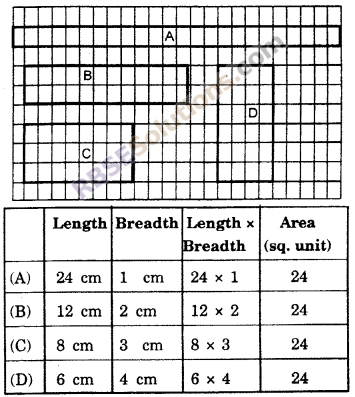
Conclusion :
Breadth increased as length decreased, but area remain same in each case.
Question 2.
Given below are figures of the (RBSESolutions.com) plots of Poonam and Pooja. Whose plot has greater area ?

Solution:
Area of Poonam’s plot = 1 × b
= 50 × 50 = 2500 sq. m
Area of Puja’s plot = I × b
= 30 × 70 = 2100 sq. m
∴ 2500 > 2100
∴ Poonam’s plot has greater area.
(Page No. 204)
Question 1.
A square handkerchief of width 20 cm is cut off (RBSESolutions.com) from a piece of square cloth 80 cm wide. What will be the change in the perimeter of the cloth if
(i) The handkerchief is cut off from a corner of the cloth. (figure (i))
(ii) The handkerchief is cut off from the middle of a side. (figure (ii))

Solution:
Perimeter of square (RBSESolutions.com) piece of cloth initially,
= 2 (l + b) = 2 (80 + 80)
= 2 (160) = 320 cm
(i) There will be no change in perimeter if we cut handkerchief like this figure, because after cutting the handkerchief two sides less and two new sides forms of same size. i.e. equal sides removed and formed.
(ii) New perimeter in this figure is as below
Perimeter = 80 + 80 + 80 + 30 + 20 +20+20 + 30 = 240 + 120 = 360 cm
In this case, perimeter (RBSESolutions.com) increased, because after cutting the handkerchief, one side of 20 cm less from a side and three new sides of 20 cm each forms their.
![]()
We hope the RBSE Solutions for Class 6 Maths Chapter 14 Perimeter and Area In Text Exercise will help you. If you have any query regarding Rajasthan Board RBSE Class 6 Maths Chapter 14 Perimeter and Area In Text Exercise, drop a comment below and we will get back to you at the earliest.